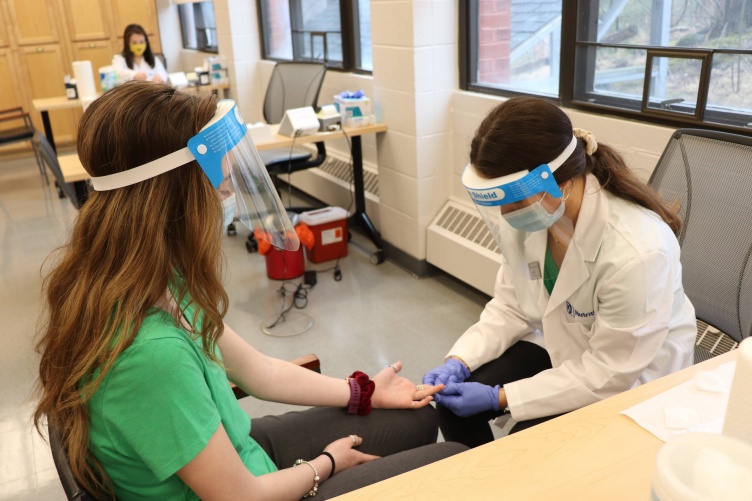
Data collection for the College Health and Nutrition Assessment Survey
In 2005, when Jesse Stabile Morrell ’99, ’04G, ’13G, principal lecturer in the nutrition program, began asking students in the Nutrition in Health and Well Being course to use the results of their own bloodwork and health assessments, she was just looking to make students feel a personal connection to what they were learning. Then she had another idea.
“I thought, ‘We’re generating all this data, shouldn’t we do something with it?’” says Morrell.
And like that, the College Health and Nutrition Assessment Survey (CHANAS) was born. Today, what began as an informal and fun way to engage students in the classroom is one of the most comprehensive databases of health and nutrition information for college students between the ages of 18 and 24 in the U.S.
Every year for the last 16 years, 90 to 95% of the 600 or so — and sometimes as many as 900 — students who enroll in Nutrition in Health & Well Being have agreed to participate in the survey. They share personal information including blood pressure, cholesterol, weight, perceived stress, eating habits, fitness level and chronic disease risk to a confidential database — as well as answer novel research questions posed by upper classmen and graduate students. To date, CHANAS has collected data on more than 10,000 UNH students.
While integrating personal data has succeeded in making coursework resonate with students, the process of collecting and analyzing the data has produced an even more significant learning experience.
"Working as an undergraduate student on the CHANAS project has been a fascinating first-hand look into research development, data collection and working with student participants,” says Nicole Yeomans ’22, a nutrition: dietetics major. “From being one of the survey participants to working in the labs during the screening process, I’ve developed a greater appreciation for research and the value of longitudinal data collection.”
Before CHANAS, not much data existed on the health and nutrition of college students between the ages of 18 and 24, a transitional time when many young adults leave home. It’s also a key time, says Morrell, for developing habits that can influence health for decades to come.
The information from the survey has been shared with UNH Dining, which prioritizes healthy eating, and Healthy UNH, which provides health and wellness resources to the UNH community, to give both groups an idea of the health status and health risk factors that exist among the student population.
The survey data also represents a treasure trove for undergraduate and graduate researchers: it has been the basis of more than 40 undergraduate student projects, 37 graduate student projects (including 10 honors theses), 27 national conference presentations and four student-led peer-reviewed manuscripts.
A study of food insecurity among undergraduates on campus by Alana Davidson ’17 uncovered a surprising number of students who reported lacking reliable access to affordable, nutritious food. With help from UNH faculty and administrators, Davidson used the survey results to create Swipe It Forward, a program that gives food insecure students access to meal credits that have been donated to a "swipe bank."
Morrell, who anticipates that CHANAS will provide valuable insight into the pandemic’s impact on student health, access to food and lifestyle behaviors, sees even more long-term potential for data.
“I think we have still-developing value in reporting out on young adult health priorities,” she says. “There is an under-recognized area of opportunity for us to help emerging adults pivot in their decisions and their lifestyle choices and help them make healthier choices from that step forward. The ripple effect would be huge.”
This article will be published in the upcoming fall 2021 issue of the UNH College of Life Sciences and Agriculture's flagship print publication, THRIVE. Read our spring 2021 issue here.
-
Written By:
Sarah Schaier | UNH College of Life Sciences and Agriculture | sarah.schaier@unh.edu





















































